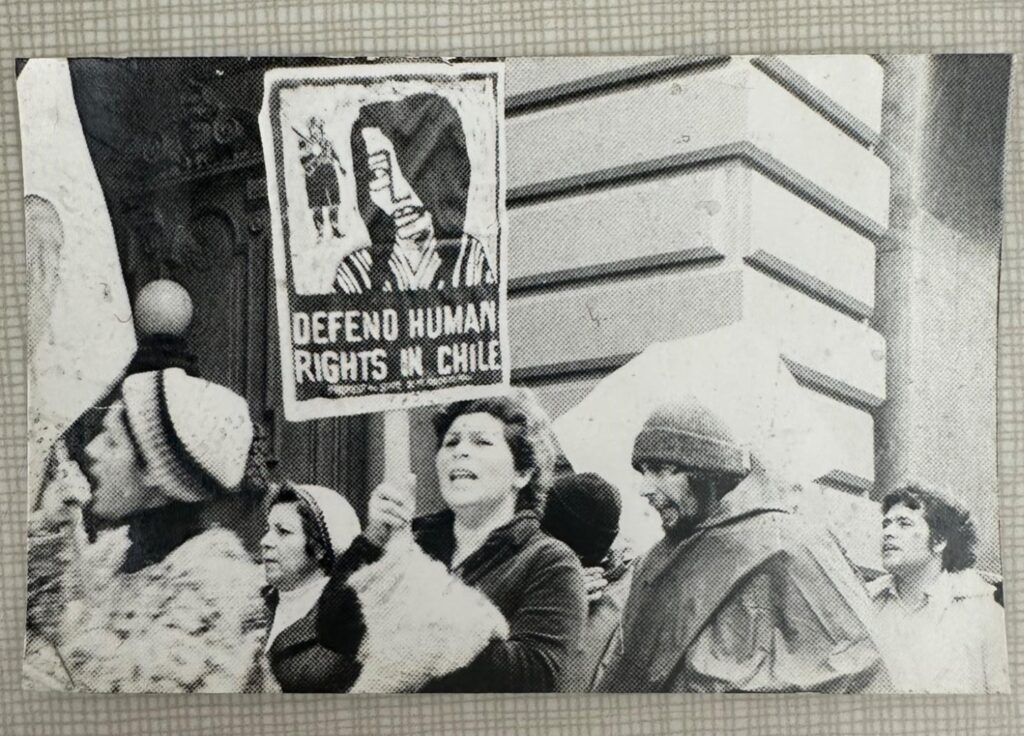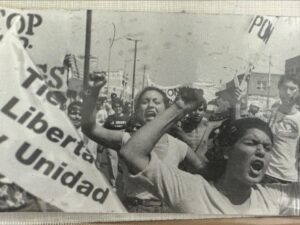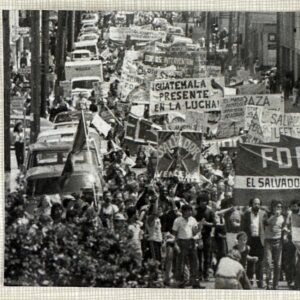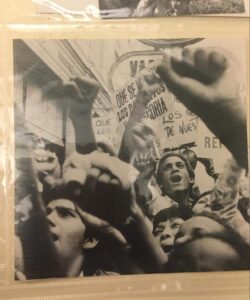Tag: San Francisco
50 Years in San Francisco’s Mission District: The Archives of Acción Latina
Photographic prints and posters from the archives of Acción Latina and El Tecolote newspaper are now available for research at Bancroft Library, with an online finding aid newly published at the Online Archive of California. This is the result of the dedicated work of Isabel Breskin, an intern in Library and Information Science at the University of Washington. Below we have Isabel’s reflections on the collection, along with snapshots of a few photographs encountered while she arranged and described the files. Organizational records and other materials from Acción Latina will be made available in the coming months. -JAE
A Guest Posting by Isabel Breskin
Acción Latina is a community organization based in San Francisco’s Mission District. The roots of the organization’s work go back to 1970, when San Francisco State University journalism professor Juan Gonzalez launched a newspaper with his students. That newspaper, El Tecolote, is still published bimonthly and is now the longest-running bilingual newspaper in the country. In 1982, volunteers from El Tecolote and New College of California staged the first Encuentro del Canto Popular, a festival celebrating Latin American music. The festival became an annual event; the 41st Encuentro was held in December 2022.
The Acción Latina and El Tecolote Pictorial Archive contains thousands of photographs, hundreds of posters and artists’ prints, as well as negatives, slides, cartoons and other drawings, and digital images. The photographic print collection and the poster and artists’ print collection are now available to researchers.
The photographs capture all aspects of life in the Mission beginning around 1970 and continuing into the first decade of the 21st century, as people took to the streets to protest and celebrate, as they went to work and school, played music and danced, painted murals and listened to poetry. I found the photographs of protests particularly compelling — and I think researchers will, too. They are both rich in information about the issues and causes of the times, and moving evidence of the passion and belief that stirred people to action.
Here are just a few snapshots I took as I worked to arrange and rehouse the photographs.
As I’ve been working on the collection I’ve been thinking about all the people involved: the many people who have been part of Acción Latina over the decades, who have lived and worked in the Mission District and have contributed to the vibrancy of its community, the photographers and artists who created these materials, and the people who will now turn to the images and learn from them.
We recently had our first researcher come to use the newly available collection. He was interested in Bay Area events related to the politics and culture of Chile. Among the relevant images in the collection is this photograph.

I am struck by the look on this unknown woman’s face – she looks both tragic and absolutely determined. It is meaningful to me that her decision to go out and protest that day is being preserved in the collection, and is being recognized and honored in the work of scholars.
The Berkeley Remix: Season 3 of the Oral History Center’s Podcast
Listen to Season 3 Episode 1 of our podcast now known as The Berkeley Remix.
This podcast is about the politics of the first encounters with the AIDS epidemic in San Francisco. The six episodes draw from the thirty-five interviews that Sally Smith Hughes conducted in the 1990s. A historian of science at UC Berkeley’s Oral History Office, Sally interviewed doctors, nurses, researchers, public health officials and community-health practitioners to learn about the unique ways that people responded to the epidemic. Although these interviews cover a wide range of topics, including the isolation of the virus HIV and the search for treatments, the interviews we selected for this podcast are more focused on public health, community engagement, and nursing care. Most of the following podcast episodes are about the period from early 1981, when the first reports emerged of an unknown disease that was killing gay men in San Francisco, to 1984 and the development of a new way of caring for people in a hospital setting.
Episode 1 explores what it was like to be gay in San Francisco in the 1960s and 70s, before people became aware of the epidemic.
Visit The Berkeley Remix for release of Episodes 2-6 each Wednesday.
Announcing the Release of the California / San Francisco Fire Departments Oral History Project
The world of firefighting is much more than masked people in uniforms running into burning buildings and rescuing scared cats from trees. While the bravery of firefighters can’t be overestimated, they also work in a complex system that requires constant training and education, a cohesive partnership with local government, extensive procedures and protocols, managerial oversight, effective communication within departments and to the public, acute familiarity with the local and regional environment, and a whole lot of administrative work. The San Francisco Fire Department (SFFD) is a shining example of how people make a civil service operation run and keep people safe. All of these elements, as well as the historic and cultural aspects of the department, are why we chose it as our focus for our California Fire Departments Oral History Project.
The project was originally conceived by Sarah Wheelock, an independent researcher. She wanted to explore several major thematic areas of firefighting in California and she worked with the Oral History Center to do just that. With great sadness we learned that Sarah passed away in 2014 and thus she was unable to see the project through to completion. Taking over the project in 2016, I wanted to honor her original plan and cover the themes that she had outlined. So, I decided to embark on interviews within one department – the SFFD – to document the ways in which they have handled urban fire, climate change, diversity, technological change, and changing demographics.
The SFFD was founded in 1849 and was run by volunteers. It became a paid department, officially integrated into city government, in 1866. The 150th anniversary of the paid department was in 2016, when I was conducting interviews. Given my budget for the project, I was able to interview six people who worked with the SFFD in different capacities. I wanted to include multiple perspectives to understand the organizational, cultural, geographic, economic, and political systems of one of the oldest departments in the country.
The individuals who I interviewed were able to illustrate many of the themes that I wanted to document, and much more. Among the six people I interviewed were Chief Robert Demmons (the first and only African American chief of the SFFD who instrumental in integrating more more women and people of color into the SFFD), Bill Koenig (longtime firefighter and co-founder of Guardians of the City and the SFFD Museum), Jim Lee (also a longtime firefighter and co-founder of Guardians of the City and the SFFD Museum), Steve Nakajo (member of the SFFD Fire Commission), Lt. Anne Young (one of the first females hired), and Jonathan Baxter (longtime paramedic and current Public Information Officer).
These interviews work in concert to illustrate day-to-day operations in the stations, administrative duties, how the city of San Francisco and the department work together, the relationship between paramedics and the department, training, equipment, fire science school, the role of unions, the challenges and triumphs of integrating the departments, the public perception of the department, the role of innovation and changing technology, cultural changes in the department, challenges in fire safety particular to the geography of San Francisco, and the hopes for the future of the SFFD.
It is with great excitement that we present the California / San Francisco Fire Departments Oral History Project. I want to give a special thanks to all of the narrators for sharing their stories with me and helping me to document one of the most historically significant fire departments in our country.
This project is dedicated to the memory of Sarah Wheelock. Her California Firefighter oral histories from the 2000s will be released in early 2018.
Trial: San Francisco Chronicle 1869-1984
The Library has a trial for the NewsBank digital archive of the San Francisco Chronicle, covering 1869-1984. This includes 61 years not covered by our purchase of the ProQuest digitized San Francisco Chronicle.
You can access the paper until November 9 through this link:
http://infoweb.newsbank.com/?db=EANX-NB&s_browseRef=decades/142051F45F422A02/all.xml
Please send your feedback to me at dorner@berkeley.edu.
Event: Visualizing History: Mapping the 1915 San Francisco World’s Fair
Join Bancroft Library in celebrating the 100th anniversary of the 1915 San Francisco Panama-Pacific International Exhibition by digitally mapping rarely seen photographs of the world’s fair onto a historic map of the fairgrounds using the Historypin platform.
The event will kick off with a gallery tour by Curator Theresa Salazar of the Bancroft Library’s PPIE exhibit: The Grandeur of a Great Labor: The Building of the Panama Canal and the Panama-Pacific International Exposition, followed by a reception and brief talk in the beautiful Morrison Library.
Participants will then work together to explore archival images of the world’s fair and try to pinpoint the exact locations where the photos were taken. Using maps and guides as you would have 100 years ago, you’ll virtually find your way through “The Zone” and its sometimes-fatal carnival rides, wander through the massive exhibit halls, and marvel at the architecture of the state and country pavilions. History “pinners” will see their results live on the Historypin PPIE site at the event. We guarantee you’ll never see SF’s Marina neighborhood the same way again!
Thursday, November 19, 2015
4:00-4:30 pm – Location: Bancroft Library Gallery
Bancroft Library Gallery Tour with Curator Theresa Salazar – meet in the Bancroft Library lobby (following the gallery tour, participants will be escorted to the Morrison Library for the remainder of the event)
4:30-7:00 pm – Location: Morrison Library
Welcome Reception and Talk by Laura Ackley, author of San Francisco’s Jewel City: The Panama-Pacific International Exposition of 1915.
Demonstration and Pinathon
After a quick tour of the virtual fairgrounds, you’ll have a chance to get hands-on working in groups to help us pin historic images from Bancroft’s collections onto the 1915 fairground map, using clues, fair guides, maps, and more.
Live sharing on Historypin PPIE Site
We will have groups share some of the just-pinned materials Live on the Historypin PPIE site—Tell us what you discovered in your time travels!
Event: Bancroft Roundtable: “Before the PPIE: The Mechanics’ Institute and the Development of San Francisco’s ‘Fair Culture,’ 1857-1909.”
Please join us for the second Bancroft Library Roundtable of the fall semester!
It will take place in the Lewis-Latimer Room of The Faculty Club at noon on Thursday, October 15. Taryn Edwards, Librarian/Historian in the Mechanics’ Institute Library and Chess Room, San Francisco, will present “Before the PPIE: The Mechanics’ Institute and the Development of San Francisco’s ‘Fair Culture,’ 1857-1909.”
Between the years of 1857 and 1899, the Mechanics’ Institute hosted thirty-one industrial expositions that displayed and promoted the products of local entrepreneurs and inventors. These expositions bolstered California’s infant economy, encouraged the demand for local goods, and whetted the public’s appetite for elaborate, multi-attraction fairs. Given the Mechanics’ Institute’s vast experience with putting on such spectacles, its members were involved as consultants on larger state-wide fairs including the California Midwinter Fair of 1894, the Golden Jubilee Mining Fair of 1898, the Portola Festival of 1909, and the Panama Pacific International Exposition in 1915. Ms. Edwards will explore this rich history through a lecture and slideshow.
We hope to see you there.
Crystal Miles and Kathi Neal Bancroft Library Staff
Event: Bancroft Roundtable: “‘The World’s Best Working Climate’: Modeling Industrial Suburbs on the Edge of San Francisco Bay.”
The last Bancroft Roundtable of the spring semester will take place in the Lewis-Latimer Room of The Faculty Club at noon on Thursday, May 21. Peter Ekman, Bancroft Library Study Award recipient and doctoral candidate in geography at UC Berkeley, will present “‘The World’s Best Working Climate’: Modeling Industrial Suburbs on the Edge of San Francisco Bay.”
Between 1880 and 1940, urban manufacturers, planners, and property developers configured a series of company towns and industrial suburbs just east of San Francisco Bay, stretching from Richmond to Antioch on the shores of the Carquinez Strait. Drawing on visual materials and numerous manuscript collections at the Bancroft, Peter Ekman will discuss how this unfashionable, ostensibly unplanned “middle landscape” came, over time, to serve as a kind of laboratory for new, imitable models of social and spatial order. He will place these experiments within a prehistory, intellectual and material-cultural, of the postwar suburb, and explore their afterlives amid decades of disinvestment.
We hope to see you there.
Crystal Miles, Kathi Neal, and Baiba Strads
Bancroft Library Staff
Event: Bancroft Roundtable: “Counter-institutions are the answer, man!” Multi-Ethnic Publishing in the San Francisco Bay Area in the 1970s.
The next Bancroft Roundtable will take place in the Lewis-Latimer Room of The Faculty Club at noon on Thursday, March 19. Simon Abramowitsch, Bancroft Library Study Award recipient and doctoral candidate in English at UC Davis, will present “Counter-institutions are the answer, man!” Multi-Ethnic Publishing in the San Francisco Bay Area in the 1970s.
In the 1970s, independent publishing in the San Francisco Bay Area was central to the development of multi-ethnic American literature. Writers, editors, and publishers of literary journals and small presses made space for literature by African American, Asian American, Latina/o, Native American writers as well as European American writing outside the mainstream. But more than simply efforts to present work by and for single ethnic groups, the development of multi-ethnic literature in the Bay Area suggested and argued for a properly multi-cultural American literature. Ishmael Reed and Al Young’s Yardbird is frequently cited as the exemplar of this movement for the multi-culture, but Yardbird was in fact only one instance of a diverse and complex range of regional efforts in this direction. The talk will discuss the history of this local literary activity by looking at some of the figures and publishing efforts in the Bay Area during the 1970s.
Kathi Neal and Baiba Strads Bancroft Library Staff
Event: Bancroft Roundtable: “Counter-institutions are the answer, man!” Multi-Ethnic Publishing in the San Francisco Bay Area in the 1970s.
The next Bancroft Roundtable will take place in the Lewis-Latimer Room of The Faculty Club at noon on Thursday, March 19. Simon Abramowitsch, Bancroft Library Study Award recipient and doctoral candidate in English at UC Davis, will present “Counter-institutions are the answer, man!” Multi-Ethnic Publishing in the San Francisco Bay Area in the 1970s.
In the 1970s, independent publishing in the San Francisco Bay Area was central to the development of multi-ethnic American literature. Writers, editors, and publishers of literary journals and small presses made space for literature by African American, Asian American, Latina/o, Native American writers as well as European American writing outside the mainstream. But more than simply efforts to present work by and for single ethnic groups, the development of multi-ethnic literature in the Bay Area suggested and argued for a properly multi-cultural American literature. Ishmael Reed and Al Young’s Yardbird is frequently cited as the exemplar of this movement for the multi-culture, but Yardbird was in fact only one instance of a diverse and complex range of regional efforts in this direction. The talk will discuss the history of this local literary activity by looking at some of the figures and publishing efforts in the Bay Area during the 1970s.
Kathi Neal and Baiba Strads Bancroft Library Staff
Event: San Francisco History Expo March 1-2
More than fifty San Francisco organizations are participating in the San Francisco History Expo, which features the history of San Francisco’s communities through displays, presentations, and showings of archival footage. Admission is $5 (though their web site says “No one will be turned away for lack of funds”).



